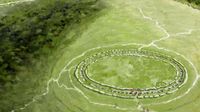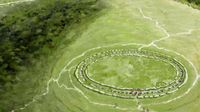A Stone Age circular monument in England is even older than Stonehenge, raising the possibility that Stonehenge's creators used it as inspiration, a new study finds.
When researchers radiocarbon-dated artifacts from the large monument, known as Flagstones, they found that it dates to about 3200 B.C. — meaning it's about 200 years older than Stonehenge. Previously, archaeologists thought Flagstones was the same age as the earliest stages of Stonehenge, which was built and reconfigured over the centuries. The researchers published their findings on March 6, 2025 in the journal Antiquity.
The discovery "makes Flagstones the earliest large circular enclosure known in Britain," said study first author Susan Greaney, a lecturer in archaeology at the University of Exeter in the U.K. "It might be that Flagstones was copied at Stonehenge, or it might be that we need to go back to our dates of Stonehenge and think again," she told Live Science in an email.
Flagstones, an ancient monument and burial site, was found in the 1980s during construction of the Dorchester bypass in Dorset, a county in southwest England. Excavations unearthed a 330-foot-wide (100 meters) circular ditch that was made with intersecting pits. The pits contain at least four sets of human remains: a cremated adult and three children, with partially cremated remains of three other adults located elsewhere at the site, according to a statement from the University of Exeter.
Now, half of the monument is under the bypass, while the other half lies beneath a historical home managed by the National Trust, a conservation organization. The site's artifacts are housed at the Dorset Museum.
Located about 37 miles (60 kilometers) southwest of Stonehenge, its similarity to the early stages of Stonehenge, which also features cremated burials and a similarly sized enclosure made of intersecting pits, led archaeologists to think the two were constructed at the same time, around 2900 B.C.
But as part of her doctoral research, Greaney compiled a more detailed timeline of a collection of Neolithic monuments in the Dorchester area whose artifacts are kept at the Dorset Museum. "With new techniques for obtaining precise radiocarbon dates, and advanced statistical methods, we can now obtain really precise estimates for when events like monument construction took place," Greaney said.
To more accurately date Flagstones, Greaney and her colleagues radiocarbon-dated human remains, red deer antlers, and charcoal found at the site. They estimated that the pits were dug around 3650 B.C., but the circular enclosure wasn't formed until 3200 B.C., with the burials placed there soon after. A young adult male, buried under a large sarsen stone at the center of Flagstones' enclosure, was placed there much later — around 2200 B.C., approximately 1,000 years after the monument was first used.
Flagstones is the oldest known large, circular enclosure of its kind in Britain, being 5,200 years old. After its construction, similar circular monuments were built in various locations. Greaney noted, "It is part of a shift from predominantly rectangular or linear monuments (cursus monuments, long barrows) or irregular enclosures (causewayed enclosures) towards circular forms."
The study suggests that circular monuments like Flagstones "may have been influenced by practices in Ireland, where people were burying their cremated dead in circular passage tombs at this time," Greaney commented.
Although the new dates suggest that Flagstones is older than Stonehenge, Greaney believes that scientists should reassess and redate Stonehenge. "There are some 'curated' animal bones from near the entrances to the enclosure at Stonehenge, which do date from around 3200 B.C.," Greaney explained. "It's been assumed that these deer bones and cattle skulls had been kept for some time before being deposited in the ditch.
With the new dates from Flagstones, it's now possible to examine these deposits, which were in slightly deeper parts of the ditch, and question whether an earlier enclosure made up of intercutting pits was later consolidated into the contiguous ditch, which occurred around 2900 B.C.,” Greaney added.


